Zimbabwe Faces Decision on Local Currency
As the nation’s currency hits record lows, citizens flock to US dollar Parallel-market rates soar with a 60% premium for greenback
Zimbabwe finds itself at a critical juncture as its currency, the Zimbabwe dollar, continues its alarming descent, reaching unprecedented lows against the US dollar. The local unit’s value has plummeted by 73% this year, positioning it as the world’s second-worst performing currency, trailing only behind the Lebanese pound. With speculation mounting that the central bank is poised to make a significant announcement regarding the fate of the Zimbabwean currency, citizens are turning to the stability of the US dollar in droves.
Trading at a staggering 22,476 against the greenback, the Zimbabwe dollar’s steep decline has sparked widespread concern among the population. The anticipation further intensified following the early assumption of office by the new central bank governor, John Mushayavanhu, prompting speculation that a new currency strategy, potentially including a shift to the gold standard, may be imminent.
The prospect of a return to hyperinflation looms large over the southern African nation, reminiscent of the crisis that led to the abandonment of the old local dollar fifteen years ago. Previous efforts by Reserve Bank of Zimbabwe governors, John Mangudya and Gideon Gono, to stabilize the currency proved futile, despite initiatives such as the introduction of gold coins and digital tokens.
Amidst the uncertainty, Lloyd Mlotshwa, head of research at IH Securities, observes a prevailing sense of anxiety among the populace, driving a preference for holding US dollars as a safe haven ahead of the anticipated currency announcement.
Reports from local media suggest that Mushayavanhu may unveil the new currency policy in a monetary policy statement by the end of the week. The release, originally scheduled for February, has been delayed to allow policymakers adequate time for refinement. David Mnangagwa, the country’s deputy finance minister, has hinted at the imminent publication of the statement, attributing exchange rate volatility to mounting anticipation surrounding the delayed policy release.
Meanwhile, the premium for dollars in the parallel market has surged by 60%, reaching as high as Z$36,000, underscoring the heightened economic uncertainty gripping Zimbabwe.
agencies














